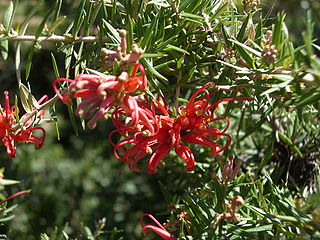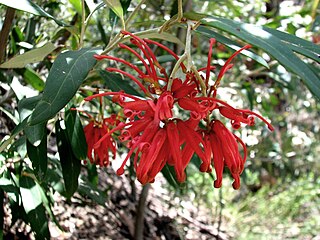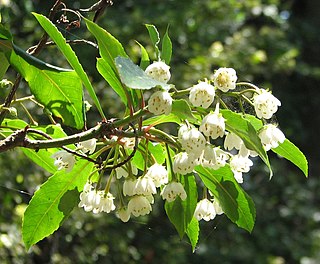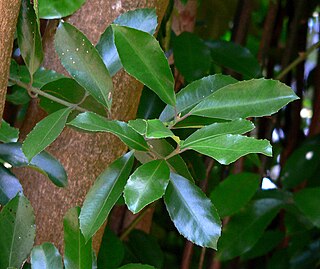
Ripogonum is a genus of flowering plants confined to eastern Australia, New Zealand, and New Guinea. Until recently this genus was included in the family Smilacaceae, and earlier in the family Liliaceae, but it has now been separated as its own family Ripogonaceae.

Pultenaea is a genus of flowering plants in the family Fabaceae-Faboideae that are native to Australia. They are known commonly as bush peas.

Cassinia is a large genus of plants in the family Asteraceae, most or all of which are native to the Southern Hemisphere. It was named for French botanist Alexandre de Cassini.

Grevillea juniperina, commonly known as juniper- or juniper-leaf grevillea or prickly spider-flower, is a plant of the family Proteaceae native to eastern New South Wales and south-eastern Queensland in Australia. Scottish botanist Robert Brown described the species in 1810, and seven subspecies are recognised. One subspecies, G. j. juniperina, is restricted to Western Sydney and environs and is threatened by loss of habitat and housing development.

Thysanotus is a genus of perennial herbs in the family Asparagaceae, subfamily Lomandroideae. They are mostly native to Australia with 45 of the 50 known species occurring in Western Australia alone, although a few species range northward into New Guinea and Southeast Asia as far north as southern China.

Grevillea victoriae, also known as royal grevillea or mountain grevillea, is a shrub which is endemic to south-eastern New South Wales and mountainous parts of Victoria in Australia.

Burchardia is a genus of herbs that are endemic to Australia. The genus is named for Johann Heinrich Burkhardt, a German botanist.

Anopterus macleayanus, commonly known as Queensland laurel or Macleay laurel, is a shrub or small tree in the family Escalloniaceae. It is native to Queensland and New South Wales in Australia.

Olea paniculata, commonly known as the native olive, is a plant of the genus Olea and a relative of the olive. It grows natively in Pakistan and southwestern China (Yunnan) through tropical Asia to Australia and the Pacific islands of New Caledonia, Vanuatu and Lord Howe Island.

Laxmannia is a genus of tufted perennial herbs in the family Asparagaceae, subfamily Lomandroideae, that are endemic to Australia.

Hedycarya is a genus of trees and shrubs of the family Monimiaceae. Species occur in South East Asia, New Caledonia, Australia and Polynesia including New Zealand. The genus was named and formerly described in 1776 by botanists Johann and Georg Forster in Characteres Generum Plantarum . The limit of the genus may require change as it appears paraphyletic in phylogenetic analyses, with the genera Kibaropsis and Levieria nested in it.

Podolobium alpestre, commonly known as alpine shaggy-pea, is a shrub which is native to south-eastern Australia. The species is a member of the family Fabaceae and of the genus Podolobium. It grows up to 1.3 metres high The leaves are 10 to 40 mm long, 3 to 10 mm wide. The yellow-orange pea-shaped flowers are produced in terminal or axillary racemes between December and January in the species' native range.

Persoonia linearis, commonly known as the narrow-leaved geebung, is a shrub native to New South Wales and Victoria in eastern Australia. It reaches 3 m (9.8 ft), or occasionally 5 m (16 ft), in height and has thick, dark grey papery bark. The leaves are, as the species name suggests, more or less linear in shape, and are up to 9 cm (3.5 in) long, and 0.1 to 0.7 cm wide. The small yellow flowers appear in summer, autumn and early winter, followed by small green fleshy fruit known as drupes. Within the genus Persoonia, it is a member of the Lanceolata group of 58 closely related species. P. linearis interbreeds with several other species where they grow together.
Grevillea brevifolia, commonly known as Cobberas grevillea, is a species of the plant genus Grevillea. It is native to the states of Victoria and New South Wales in Australia. The red flowers appear between November and December in the species' native range. The species was first formally described by Victorian Government Botanist Ferdinand von Mueller in 1879 in Flora Australiensis, based on a collection from Mount Tambo in Victoria. The former subspecies G. brevifolia subsp. polychroma was elevated to species status as Grevillea polychroma in 2005. Grevillea brevifolia is listed as "Rare in Victoria" in the Department of Environment and Primary Industries' Advisory List of Rare Or Threatened Plants In Victoria. The species occurs in sub-alpine areas including the Pilot Wilderness, the Cobberas-Tingaringy Unit of the Alpine National Park, and Mount Seldom Seen.

Eutaxia microphylla, also known as common eutaxia, is a shrub species in the family Fabaceae. The species is endemic to Australia.

Chenopodium parabolicum, commonly known as fragrant saltbush or mealy saltbush, is a shrub in the family Amaranthaceae. The species is native to Australia.

Agastachys odorata, commonly known as the white waratah, is the sole member of the genus Agastachys in the protea family. It is an evergreen shrub to small tree and is endemic to the heaths and button grass sedgelands of western Tasmania. It occurs most often in moist heath and scrub and occasionally in the alpine regions, but generally prefers well-drained but poor soils. It can grow in some rainforests where it forms a small tree but is normally a shrub in all other situations. The heaviest concentrations are along the island's south coast. Its leaves are dark green, hairless and almost succulent. Masses of white flowers are produced in erect spikes from the ends of the branches. Measuring 8 to 12 cm high, they appear in January and February.
Grevillea stenobotrya is a shrub in the family Proteaceae. It is endemic to arid regions of Australia. Common names include rattle-pod grevillea, sandhill grevillea and sandhill spider flower. Plants grow to between 1.5 and 6 metres in height and have leaves are linear and entire, or occasionally divided, and between 6 and 28 cm long and 0.7 to 2.5 mm wide. Flowers are cream, pale yellow or pale pink. These appear in clustered spikes at the end of branches between May and December in the species' native range. The fruits which follow are hard, flattened and rounded and have a short beak.

Ozothamnus cuneifolius, commonly known as wedge-leaf everlasting or wedge everlasting, is a shrub in the family Asteraceae. It is native to forests of the south-east of New South Wales and Gippsland in Victoria in Australia.
Barry John Conn, is an Australian botanist. He was awarded a Ph.D. from Adelaide University in 1982 for work on Prostanthera.

















